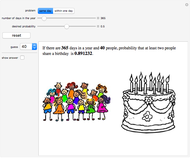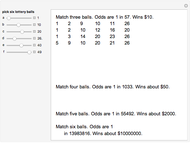Coverage Probability with the Occupancy Problem

Requires a Wolfram Notebook System
Interact on desktop, mobile and cloud with the free Wolfram Player or other Wolfram Language products.
In probability theory, the "occupancy problem" considers throwing  stones into
stones into  buckets. If each stone has equal probability of entering any bucket, what is the probability there are
buckets. If each stone has equal probability of entering any bucket, what is the probability there are  empty buckets?
empty buckets?
Contributed by: Aaron Becker (January 2014)
Open content licensed under CC BY-NC-SA
Snapshots
Details
Given  buckets and
buckets and  stones, the probability that there are no empty buckets is
stones, the probability that there are no empty buckets is  .
.
More generally, the probability that  of
of  buckets are empty after throwing
buckets are empty after throwing  stones is
stones is  .
.
Example 1: if you roll a fair die 10 times, what is the probability that you see all six sides?
Example 2: In her book The Hunger Games: Catching Fire by Suzanne Collins, after 74 games one male and one female victor are selected from 12 districts ( ,
,  ). Is it reasonable to assume each district has a female and a male victor?
). Is it reasonable to assume each district has a female and a male victor?
Displayed in blue for  is the expected number of stones to throw to get at least one stone in each bucket
is the expected number of stones to throw to get at least one stone in each bucket  , where
, where  is the harmonic number
is the harmonic number  . This problem is also known as the coupon collector's problem with
. This problem is also known as the coupon collector's problem with  different kinds of coupons. Many coupons are distributed randomly; the above relation gives the probability of having the complete set after
different kinds of coupons. Many coupons are distributed randomly; the above relation gives the probability of having the complete set after  purchases.
purchases.
Reference
[1] W. Feller, An Introduction to Probability Theory and Its Applications, Vol. I, 3rd ed., New York: John Wiley & Sons, 1968.
Permanent Citation


































